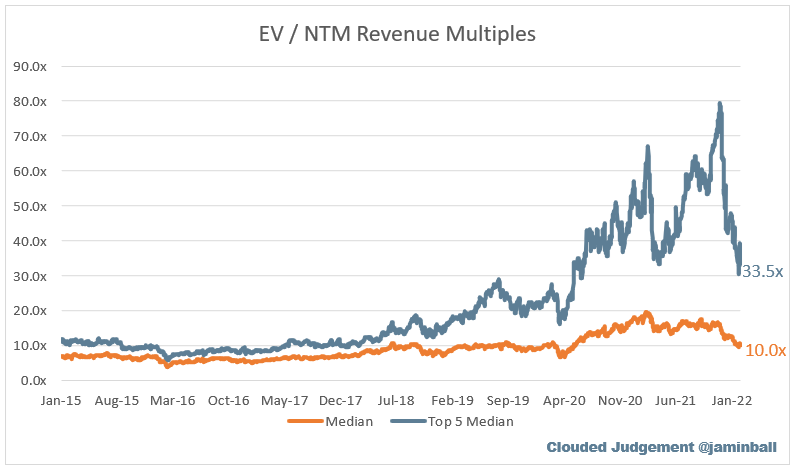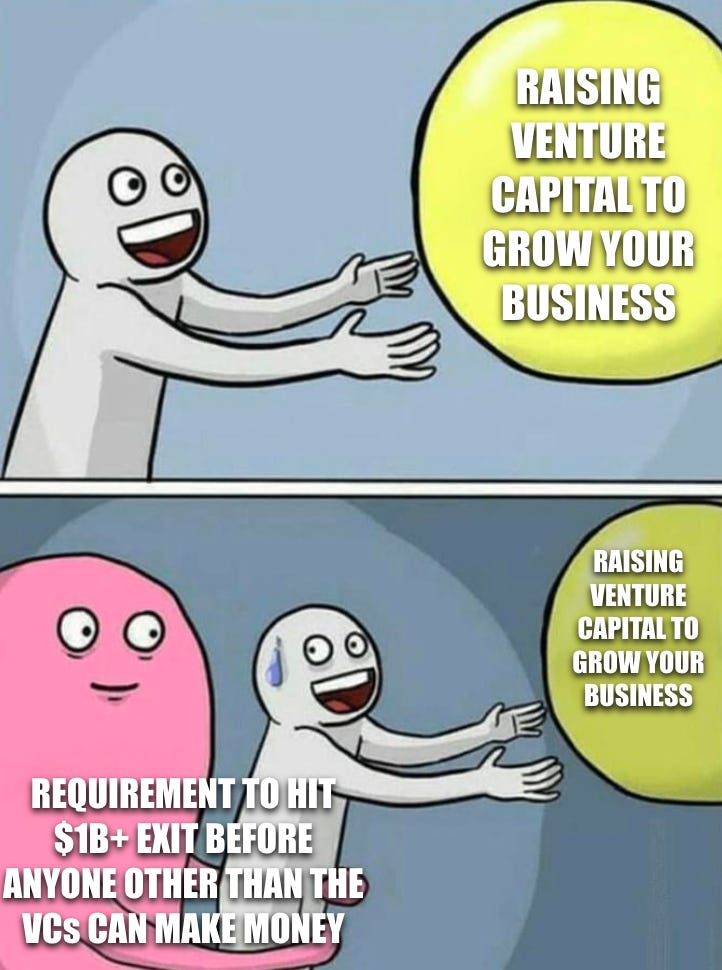In the late 80s, early 90s my Dad was in almost exactly the same phase of life as I am now. We're both in our 30s and about to have our 3rd kids. In just that generation the world has changed dramatically. Technology went from 9% to 20% of the S&P 500 between 1980 and 2020. In 2011 we realized "software was eating the world" and in 2021 we decided we'll see unicorns as often as we see cows on a roadtrip. Technology has become inevitable in almost every facet of our lives.
So for those of us who work in tech (as founders, employees, or investors) the ubiquity of technology can also start to feel like the ubiquity of success. If you're a founder today you're constantly bombarded with podcasts, thought pieces and VC twitter threads about how "it's a seller's market" and how "there's never been a better time to be a founder."
But for some founders this isn't the case. You read the articles, you do customer research, you build the product, you test it, you iterate. You can't seem to quite hire the caliber of people you'd like to but you do okay. You go out to raise money and it's not very easy. Most VCs will only talk casually. Or they'll commit to a capped note but only if you find a lead. You try and close a customer but they'll only pay a fourth of what you'd hoped they would pay (and what they said they would pay in user interviews.)
Founders in that situation will ask themselves, "What am I doing wrong? This doesn't sound like what I read about in Techcrunch at all." I love founders like Amira at Mos who have moments of success and stop to remind people that it isn't always easy.

But there is more going on than just keeping a handle on your mental wellness as a founder. There is a legitimate economic bifurcation between companies. This is happening in public and private markets where the divide among companies between the best and the rest is becoming more defined.
The Haves and the Have-Nots
Conveniently the most clear visualization of the divide between the best and the rest comes out weekly thanks to Jamin Ball's "Clouded Judgement." I think about this particular graph every single week:
At the very peak a few months ago the contrast was insane with the top 5 median at 74x vs. 16x for the rest. With the recent market correction you've seen that come down a lot but the difference between a 33x multiple vs. 10x is still dramatic. If you're a business expecting $500M of revenue next year that's the difference between being a $5B company or a $17B company.
This past week those 5 top names included Snowflake, Cloudflare, Confluent, Datadog, and Zscaler. Some other frequent names in the top 5 include Shopify, Bill.com, Coupa, Zoom, Crowdstrike, and SentinelOne with some popping in only for a few weeks (UiPath, nCino, Unity).
Some of these companies benefit from moments in time, like Shopify and Zoom exploding during COVID. But by and large what drives this stark contrast? If you look back historically the divide wasn't nearly as dramatic up until around late 2018 / early 2019.
There's no magic answer. Could be the Fed's rate hikes that were announced in late 2018. Similar to the market correction we're experiencing right now investors were forced to really stress test their long term growth assumptions and segment out the best businesses from the average.
I wrote last week about the valuable learning lesson in noticing what valuations have dropped most dramatically during the last few months. There are some noticeable differences in the way some companies have been impacted.
Whether it's the good (Datadog only down 16% from ATH or Confluent down 10%), the bad (Coupa down 64% from ATH and UiPath down 59%) or even looking outside this comp set for the ugly (Robinhood down 79% from ATH or Peloton down 81%).
What Does "Good" Look Like?
There are a lot of different reasons why a company will be successful. But the key takeaways from the last week seems to revolve around the dramatically underestimated quality of cloud infrastructure. Companies like Datadog and Confluent are among the top 5 companies with highest revenue multiples along with other infrastructure names like Snowflake and Cloudflare. The ability for high quality cloud businesses to outperform expectations has been rewarded in the public markets.

Not every company can be AWS. And not every company will be directly leveraged to cloud adoption the way many of the biggest winners in the public markets are today. But what does a good company look like?
Every year KeyBanc puts out the results of their private SaaS company survey. Rather than showing the very best they show, by definition, what an "average" software company looks like.
With the median revenue growth rate across the board at 31% that will put you squarely in the "average company" bucket. AWS is growing at 40% with $71B in revenue, and accelerating. SentinelOne is growing revenue at 116% YoY when they're at $169M in revenue. Investors are being required to justify the long-term potential for the businesses they invest in. Sustaining and even accelerating revenue growth is a key part of that.
The same is true in private markets. You're starting to see a divide between founders and investors who are focused on "quietly building real products and steadily scaling real businesses" vs. those who are chasing exorbitant paper markups for businesses that don't have a very reasonable narrative to justify their price.
There are plenty of ways to build a great business and becoming the absolute best in the world is not the only path. There is nothing wrong with building a great business that serves customers and grows at a nice clip for years and years. But when you're talking about venture-backed companies there is an inherent expectation in terms of the return potential. The problem comes when companies with average results and potential (e.g. $100M revenue growing ~30%) expect valuations at 30x revenue when companies like Zendesk have $1.2B in revenue growing ~30% and are only trading at 9x.
"Improved Odds"
When a founder sets out to build a business they have a critical decision to make. The size of the outcome you want to pursue will dictate the methods you use to get there. When you raise venture capital at higher and higher valuations you're picking up one end of the stick. The other end of the stick is a host of expectations around how big your outcome needs to be. There are a lot of founders who want to pick up the stick with the 100x higher valuation without having to pick up the requirement for a 100x larger outcome.
But for the founders who understand what they're signing up for in taking on a venture-backed startup they also understand the aspiration. They do want to become one of the top 5 companies. The ones with the highest valuations, the revenue growth accelerating at scale, and the platform potential. And for those founders there are VCs lining up to get into the trenches with them.
I've written before about how VCs are differentiating the product they offer to founders. When answering the question, "what product do founders want to buy from investors?" Bryce Roberts summed it up perfectly:
Great founders who accept the responsibility of taking on venture money are also smart enough to understand the minuscule statistical likelihood of becoming one of those massively successful "best-in-the-world" companies. So they set out to improve their odds. If you want to join that elite club of companies how exactly do you improve your odds?
Do Yourself Some Favors
Taking money from a good VC isn't the only way to improve your odds. Every aspect of building a business is about increasing the likelihood of success. Huge credit to Mark Goldberg who I worked with at Index. This "do yourself some favors" framework comes almost entirely from him.
Market Maketh The Money
I recently had the chance to brainstorm with a young soon-to-be founder as they thought through different business ideas. One of the ideas they were kicking around? Gas station software. We had a great mental sparring session back and forth but ultimately it come down to one key fact. "Between 1994 and 2013, the number of retail fueling sites in the U.S. fell from 202,800 to 152,995—a 25 percent decline."
Is there an opportunity to build a big business in gas station software? Could be. PDI Software is a PE-owned business with hundreds of millions in revenue and has acquired 5+ businesses in the space. Are there some interesting tailwinds on the horizon that could create a good entry point? Like the need for conversion into charging stations? Or the utilization of convenience stores by 10-minute delivery startups? Definitely. And if you feel so inclined to build gas station software then dive in with all the confidence in the world.
But if you don't feel like gas station software is the only reason God put you on this earth, then maybe do yourself a favor and pick a market that is actually growing.

Not only does this help in terms of increasing the likelihood of your ability to build towards a large outcome, but it’s also a critical piece of the puzzle that investors are going to focus on. You already have to spend a fair bit of time convincing investors about you, your team, your product, and your partners. The one thing that you should hope to let speak for itself is the size and growth of the market.
Build a Talent Vortex
Talent is quickly becoming the final frontier for tech companies. Open source software, GTM playbooks, and thousands of experienced advisors and investors have decreased the need to reinvent the wheel. Talent, on the other hand, is a zero sum game. If Candidate A goes to work for Company B then they can't go work for Company C (most of the time.)
Mark Goldberg at Index articulated this perfectly when he laid out what he saw at Plaid. Creating a talent vortex sounds like something everyone will say they have but very few companies actually do. When you ask the smartest people you know "where are the smartest people YOU know going to work?" you can't fake it when the response starts to get consistent.
"I first learned about Plaid in 2015, when I asked the smartest people in my network which companies they were seeing attract and recruit the best people. When a talent bar is held high, people notice and pay attention." (Mark Goldberg)
When the pressure mounts to get things done it can feel like a fix to lower the bar and just get people in seats to get things done. But compounding works both for and against you. Those early hires will bring their networks with them and it will grow and grow. Creating a vortex of talent.
Become an Index Bet
While Elad Gil gets the credit for this idea it became a big part of how Mark and I made investments at Index (no pun intended.)
"One lens through which to view companies is to ask "what companies are an index of their underlying market"? Index companies often take a cut of every transaction in their space, or are a piece of infrastructure everyone in the market needs. These companies may be ways to participate in the market broadly without having to worry about who wins in it." (Elad Gil)
In some instances there is an intense competition to become the only solution in a particular space. This happens a lot in application software where every user is either going to use interface 1 or interface 2 to get the job done.
But companies like Stripe, Coinbase, or Nvidia have become ways to bet on digital payments, crypto, and AI without having to know who the right winner is. When you think about necessary infrastructure you have companies like Twilio for communications, Plaid for banking data, Check for payroll data, or Cohere for NLP. These companies will be successful as long as there is increasing demand for the underlying data infrastructure they provide.
The more effectively a company can position themselves as an index of a large and growing category they tie their fate not just to their own execution but also to the success of the overall trend. Just make sure you're not the betamax of your category.

Inspiration > Experience > Starting For The Sake Of Starting
We've talked about a few things founders can focus on to increase their odds. But even before becoming a founder you can do yourself a real favor by analyzing your motivations.
A number of successful founders have jumped immediately into starting a business. Elon Musk's early career is surprisingly similar to a lot of young talented people I talk to these days. Towards the end of school he had two internships (an energy storage research institute and a video game developer), applied for a job at Netscape (1994's Google APM program), and then decided to start Zip2.
Dylan Field is another more recent example. At the age of 20 he became a Thiel Fellow, dropped out of college, and founded Figma, spending 4 years building it before releasing it publicly in 2016. Fast forward to 2021 and Figma is worth $10B.
If you see a large and growing market, if you have an idea that you feel is a unique perspective on a space, and you feel like you have the mental fortitude to weather a lot of disappointments then I would call that inspiration. Jump into building something new.

But if you don't feel lightning strike with inspiration there is no harm in seeking out experiences first. For every Mark Zuckerberg or Bill Gates there is a Jeff Bezos who worked at D.E. Shaw or Reed Hastings who worked at Adaptive Technology.
When you look at the newer generation of big companies you've got people like Daniel Dines who spent 4 years at Microsoft before starting UiPath. Ali Ghodsi was an academic for 15+ years before starting Databricks. Chris Britt worked at Accenture, Visa, and several other companies before starting Chime.
Starting something for the sake of starting something can be a path towards "building a solution without a problem." Pursuing experience can be a powerful way to improve your odds.
The Road Not Taken
Originally the subtitle I had written down for this article was "The Unfair Bifurcation of Investable Companies," but the more I thought about it the more I felt the word "unfair" was out of place. There are plenty of things that are unfair in startups and venture investing for a lot of different reasons.
But the things we've talked about in terms of companies tackling big markets, focusing on acquiring talent, and attaching themselves to an index of a growing opportunity is part of the game that needs to be played for companies to become really large outcomes. And by nature those are all hard things to do. As a result there will be a divide between the businesses that pull it off and those that don't.
Building a company, whether as an employee or a founder, is already the road less taken. It may not feel that way in your social circles but in the grand scheme of what all 8 billion people on the planet are doing it's still rare. Building a large and successful company is a real challenge. Few have pulled it off. But for everyone who has picked up the high-growth venture-backed startup stick? That's what they’re all striving for. May the odds be ever in your favor.









